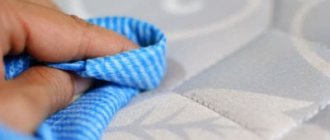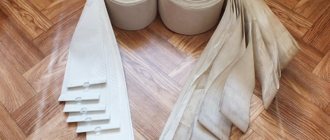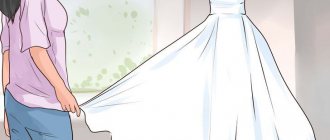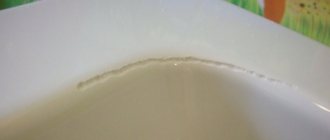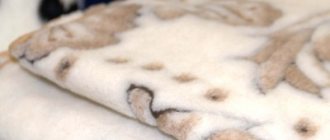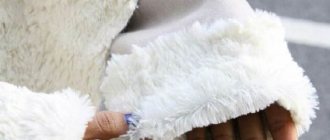A down scarf is a classic symbol of antiquity, and now it is one of the most fashionable accessories in every girl’s look. Initially and to this day, it is hand-knitted using a cotton or silk thread interwoven with the finest goat down. The most famous products are from the Orenburg region. It was there that a special breed of goats with a weightless undercoat was bred. Thanks to him, the canvases are light, like a spider's web.
Since ancient times, downy items have been considered a kind of family “gold”, which means they need appropriate care. We’ll talk about how to wash a down scarf at home, all the subtleties and features of this delicate process that will help keep the product new and well-groomed for as long as possible, in this article with video.
This is interesting: it has been noticed that fluff “climbs” out of the new fabric within a few wears. This is a natural process of getting rid of hairs of different lengths, and therefore there is no need to worry.
How to properly wash a down scarf or scarf at home by hand?
The down scarf is delicate, beautiful, airy. Made by the hands of a craftswoman, it freely stretches through a wedding ring, and the entire triangular web scarf can fit into a goose egg!
It is not surprising that many people do not dare to wash their down scarf themselves and take it to the dry cleaner. But if you want to comprehend this science yourself, five basic rules for washing down products will help you.
A down scarf is as delicate and fragile as its owner
The first and most important rule is that washing a down scarf should be done as rarely as possible. This does not mean at all that you need to wear a headscarf until the last minute, when you no longer want to look at it. But you should take care of it, try not to get it dirty, and also avoid being in smoking areas, as the scarf quickly absorbs odors. When you remove it, store it in an organizer or fabric bag to protect it from accidental contact with dirt and snags.
The second rule for washing down products is preparation directly for the washing procedure. Be sure to comb the scarf carefully so that the fluff does not fall off during washing. To do this, you will need wooden combs: a brush and a comb with rounded tips. First you need to comb it carefully with a brush - then with a comb, so as not to touch the loops.
The third rule for washing down products is hand washing, and only hand washing. No matter what kind of machine you have, a real down scarf will not survive this drill. When washing the scarf, do not rub, twist, or stretch. To wash, use colored laundry gel, dissolve it in warm water and carefully place the scarf in it. Let it sit and, as if making a snowball, wash it with gentle movements. Rinse in 4-5 waters with the same movements.
The down scarf can only be washed by hand
The fourth rule for washing a down scarf is that the washing water is neither cold nor hot. Optimal - 35-37 °C. At this temperature, the scarf will “open up”, wash well, and will not bunch up. Also note that for soaking, washing and rinsing it is advisable to prepare water at the same temperature. You can add vinegar or lemon juice (without seeds or pulp) to the last rinse to soften the fluff after drying. A special rinse aid for down products is also used.
The fifth and final rule is spinning and drying the product. You should wring it out in the same way as washing it - form a “snowball” with light movements. But it’s best to put the scarf in a net after the last rinse and hang it so that the water runs out. After this, spread out a terry towel and lay a scarf on top of it. After an hour, change to a dry towel and so on until completely dry. Be sure to completely straighten the product, but do not stretch it when drying. Shake the scarf every time you change it to help fluff up the fluff.
Drying a down scarf on a frame
If you are drying a scarf in the summer, there is a great way to fluff the product. To do this, after all the water in the net has drained from the scarf, put it in a bag and put it in the freezer for 6 hours. Then take it out and lay it out in the sun. Water expands at sub-zero temperatures and melts quickly when exposed to sudden heat, thereby achieving fluffy yarn without unnecessary movements.
Now, knowing these five rules, you can easily wash and restore your favorite accessory for the cold season.
Myths or truth?
Anyone, even the most uninitiated, knows that a down scarf is not an ordinary thing and should be washed in a special way. At the same time, before washing a shawl, a woman is faced with some statements regarding the care of knitted down products at home. Let's see if they are so categorical.
- Down items can only be washed by hand; machine washing is contraindicated for them. Manufacturers of washing machines are convinced that their “brainchild”, when using delicate modes, is capable of washing even the finest cashmere. At the same time, many people have ruined their favorite knitted items by washing them in the machine, even in the “wool” mode. Of course, for the most delicate down scarves, hand washing is preferable. However, in extreme cases, they can be entrusted to the washing machine by selecting the delicate wash mode, BUT at the same time adjusting the water temperature to cold. That is, the temperature during washing should be as it is, without heating. As mentioned above, the water temperature during washing and rinsing must be the same, otherwise the product will shrink. If you do not adjust the temperature program, washing will proceed at t = 30 ° C, and rinsing will be done at the temperature that comes from the tap.
- You should wash down items using special products for wool or silk. It is worth clarifying: it is prohibited to use powders with bleaching particles, but special products can be replaced with regular shampoo for washing hair. This is explained by the fact that wool is a natural material just like hair. The shampoo is designed to make hair silky, soft, and prevent tangling. So a down shawl can easily be washed with hair shampoo, and then instead of fabric conditioner, apply hair balm and rinse.
- Down products are dried directly on a special hoop. This drying method is the most convenient, allowing you not to iron shawls and stoles after washing. However, there are alternative methods, for example, horizontal drying. The method of drying a down scarf or stole on a special hoop can be replaced by stretching it on the carpet. To achieve this, the scalloped product should be pinned to the carpet with nails or stainless steel (or copper) pins. In this position, the down item is left until completely dry and for another 12-18 hours.
Also interesting is the method of freezing (in the freezer) a damp down scarf. When exposed to frost, water droplets turn into ice crystals and are then shaken off the scarf. Snow and frost generally have a positive effect on down products
So, to refresh the shawl, you can roll it in snow in frosty weather, and then shake it gently
Caring for down products is not as difficult as it might seem. One wash, carried out according to all the rules, will not spoil the item. But the third to fifth ones will still make themselves felt. Therefore, treat scarves and shawls with care. The less you wash them, the better they will look.
How to properly wash a down scarf in a washing machine?
Now there are many gentle programs, and one of them is washing down products. But you must admit, there is a significant difference between a down jacket made from raincoat fabric or poplin, which tightly envelops the down, and the most delicate down scarf.
The down scarf accepts hand wash only
Therefore, if you do not want to part with your favorite scarf, you should not put it in the washing machine, even in a case or net for washing, on the most loyal program. If you read how to wash a down scarf by hand, then it has already become clear that washing it is very specific and requires maximum care.
Important points when whitening
During the bleaching process, it is necessary to strictly follow the technology and sequence of actions. Do not overexpose the product in the solution or add a lot of product to enhance the effect. The ideal option for how to bleach cobwebs without risks is to test the bleach on a small fragment (a flap intended for experimental washing is applied to some products). If the down scarf has been inherited, it may have originally been cream in color. In this case, it makes no sense to carry out 2-3 bleaching sessions in a row to achieve a snow-white shade. Too strong products can destroy the structure of the fluff and the cobwebs will spread.
How to properly wash a white Orenburg scarf?
Washing white fluff has its own peculiarities, because over time it turns yellow and during washing, using some tricks, you can return the original whiteness.
Important: down products cannot be bleached with chlorine and powder/gel bleaches sold in stores.
How to properly wash a white Orenburg scarf?
To work, we need hydroperite or hydrogen peroxide.
We weigh the product - for every 100 grams of product we need 20 ml of hydrogen peroxide or 5 tablets of hydroperite. After diluting them in water, add an additional 1 tbsp. spoon of ammonia per liter of water.
Place a handkerchief in warm water with the completely dissolved mixture and leave for 6 hours. Maintaining temperature is important. To do this, place the basin on a heating pad or pour the solution into a pan and wrap it in a blanket to maintain the temperature.
After 6 hours, we take out the scarf, rinse it in six warm waters, throw it on a net and put it in a bag, which we put in the freezer for another 6 hours. Take it out and put it in a warm place to defrost. Shake and lay out to dry.
How to properly wash a goat down scarf?
Goat down is distinguished by its specific smell. And while sheep wool (including its strong aroma) has developed positive dynamics and loyalty over the centuries, the smell of goat fluff irritates many. Perfume will not help - after all, it contains alcohol and can leave stains on a beautiful product.
Therefore, proper washing is the key to the longevity of your favorite product. Pour the washing gel into the basin (it dissolves easily and has a good aroma). Add warm water and place a handkerchief in the solution. Leave for an hour and wash as indicated in the first section.
How to properly wash a goat down scarf?
In the penultimate rinse, add 50 grams of vinegar (don’t be afraid of the strong smell, it will rinse out).
In the last rinse, add conditioner gel for down products and leave the scarf in the solution for an hour.
Throw it onto a net and dry it on a towel or frame in the fresh air or draft.
What is special about the material from which the shawl is knitted?
Traditionally, shawls are knitted from soft and airy goat down. This is the undercoat of the Angora goat, which is much superior to ordinary wool in its properties: thermal conductivity, breathability, lightness. There are legends about the healing properties of scarves and shawls made from goat angora. It is not for nothing that people gave goat down a second name - “soft gold”. The most prized products are those that are the result of hand spinning. This is a real exclusive, created through long, painstaking work.
As for caring for the shawl, it is as delicate as the down scarf itself.
Careful handling is important during wearing. A woolen scarf absolutely does not tolerate tight twisting, friction, stretching, or washing in hot water.
By the way, you need to wash your shawl as rarely as possible. Additionally, she needs protection from voracious moths, for which fluff and wool are a desirable delicacy.
How to properly wash a gossamer down scarf?
The web is almost weightless and yet so warm. It should be treated with the utmost care when washing so as not to damage the product. So let's get started:
- Comb the product;
- Pour warm water, pour in detergent and put a scarf in it, leave for 30 minutes, periodically shaking the water, but so that the scarf barely moves in it;
- Now drain the water and drop the scarf onto the mesh (so that all the solution is drained and as little of it remains on the scarf as possible);
- After 15 minutes, place the scarf in warm water with a drop of vinegar, rinse with light movements, and change the water 2 more times. Add rinse aid for down products to the last water;
- Place on a net and let drain for half an hour;
- Place in a bag and place in the freezer for 6 hours (to fluff up the cobwebs);
- Take it out and put it in the sun for 15 minutes. Shake and level on a towel. Leave the scarf until it dries completely (the web dries quickly, there is no need to change the towel).
Preparation for the process
Before you begin wet cleaning, the product must be prepared. First, the scarf is shaken to remove all the particles that have not yet become embedded in the down layer.
Then the item is combed with a wooden comb with rare blunt teeth . This procedure allows you to preserve the fluffy cover of the shawl. Next, using a dry sponge, remove dust and fine dry dirt from the canvas.
You should comb a fine knit item very carefully so as not to snag or break the thread.
If there are stains on the web, they are bleached before general washing. The method of removal depends on the type of pollutant.
To remove colored marks, use an aqueous solution of high concentration aspirin . Of the ready-made chemical preparations, oxygen stain remover intended for children's things is suitable.
How to properly stretch a down scarf after washing: tips, video
When washing a down scarf, it is important not only to wash, but also to dry the product. In order for it to have a beautiful shape, it must be dried correctly: do not stretch or crumple.
In order for the work not to be complicated and at the same time effective, it is worth remembering:
- First, let the scarf drain on the mesh and only then lay it out;
- Change the bedding once an hour so that it dries well on both sides;
- When changing the bedding, we shatter the scarf, thereby safely fluffing the yarn;
- Dry away from the kitchen, smoking areas and other strong odors. Wet fluff is simply instantly saturated with the odors that are around;
- Dry in a warm place, but not in the open rays of the sun, so that the color does not fade and the white does not turn yellow.
What substances harm the product?
You can wash your shawl only with mild detergents – liquid soap or gel. Washing powder with optical brightener is not recommended; its solid particles are difficult to remove from the fibers when rinsing. The powder will make the item hard and pellets will form. To remove old stains, do not use products containing chlorine or professional stain removers. Aggressive substances can destroy thin threads, making a hole, then the product will have to be thrown away. Using laundry soap, even in the form of shavings, negatively affects the color. Yellowness will appear, causing the item to lose its attractiveness. Exposure to alkali causes the delicate material to become thinner.
Improper drying and prolonged exposure to sunlight can be harmful. Vertical drying near heat sources can lead to loss of shape, creates a fire hazard, and is easily flammable. And sunlight causes the color to fade.
Cleaning can only take place at home; detergents used in professional dry cleaners are not suitable for such delicate fabrics. The sequence of actions should be strictly followed: carefully prepare the product before the procedure, select the appropriate product, rinse and dry. If you follow the rules and treat them with care, the washed item will become like new and will delight you with soft, fluffy snow-white fluff for a long time.
The article has been verified by the editors
How to fluff a down scarf after washing?
Important: do not stretch or comb wet yarn under any circumstances.
For better fluffing, after the main amount of water has drained from the scarf, it is recommended to put the scarf in the freezer for 6 hours, first placing it in a bag. And during the drying process, shake the product once an hour.
The ideal comb for fluffing up a scarf
After complete drying, we take, as when preparing the scarf for washing, a massage wooden brush with rounded ends. Comb carefully, without jerking. After this, we need a comb also with rounded teeth. Comb carefully, without catching the loops. Ready!
When do you need dry cleaning and when do you need a full wash?
With frequent wear, the down covering and the wool thread itself can become covered with dust and dirt. The shawl actively absorbs all kinds of odors, so it is recommended to protect it from cigarette smoke and strong perfume .
If there are no visible stains or local darkening on the scarf, and there is no unpleasant odor, then you can limit yourself to periodic dry cleaning. If the shawl gets wet, it must first be dried at room temperature.
Clean the scarf from light dirt with a soft sponge. It is gently passed along the canvas, without strong pressure.
Suitable for deeper dry cleaning:
- bran (rye, wheat);
- cereals;
- potato flour;
- talc.
The natural product powder is heated in a water bath until hot. Then the bran or powder is carefully rubbed onto the scarf.
The remaining cleaning agent is shaken out or removed using a vacuum cleaner. It is advisable to repeat cleaning the most contaminated areas twice.
If the “cobweb” is very dirty and the fluff is matted, then dry cleaning may not cope with the task . A soap solution will help solve the problem. Washing is also used if local contamination appears on the item.
It is recommended to wash a shawl only when absolutely necessary, as too frequent washing deteriorates its quality.

